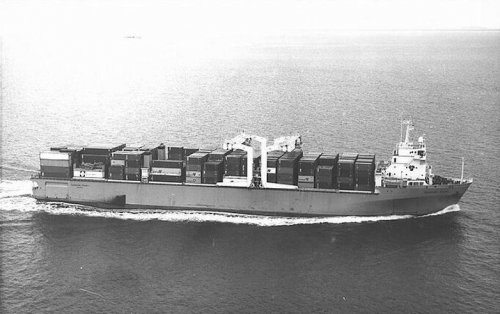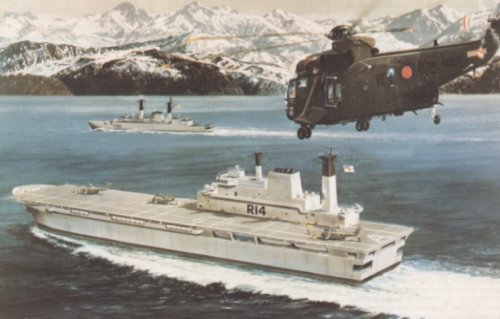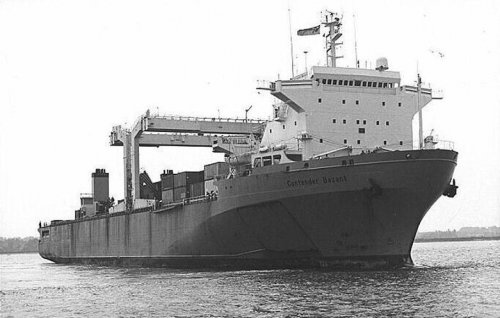I have an article from International Defense Review (issue 8/1987, pg 1029-31) that provides some more details, including an overhead and sideview sketch. I don't have scanner, but I'll summarize.
As mentioned, this is indeed the proposed conversion of Contender Argent to serve as an aviation support ship (unfortunately abbreviated as ASS). The initial proposal (early 1985) was supposed to cost around 75 million pounds and had an armament of four LS30 (now DS30) 30mm guns with Type 994 surveillance radar, two Kelvin-Hughes navigational radars. Countermeasures were to consist of Sea Gnat chaff/flare launchers and the ubiquitous Type 182 towed torpedo decoy. By the end of 1985, when the formal Naval Staff Requirement was issued, two lightweight Seawolf launchers and a Type 911 tracker were added--that's the version seen in the pictures here. Cost would have been around 85 million pounds [I'm skeptical -- Seawolf alone would add at least 10 million, and fairly dramatic hull alterations were planned as well.]
The flight deck grew from 162m x30m in the original proposal to 170m by 34m in the final, with the goal of having six Sea King landing spots plus parking space for six more -- each sufficient for a single company lift of RM Commandos. The two elevators were changed from a tandem configuration ahead of the island to a staggered one. The final hangar was 1,300 m2, providing room for 12 Sea King or EH101 or a similar number of Harrier (the elevators were sized to accommodate Harrier GR.5). The deck was strengthened for Chinook, which would fit on the elevators and in the hangar, but only with rotors removed. Aviation fuel capacity was 1,000 tonnes. [No mention of air ordnance, other than a later mention that the magazines could accept standard weapons, and that modular equipment in the vehicle cargo spaces could convert the ship for an ASW role.]
There was a 1,500-m2, two-deck vehicle garage aft, with access to the hangar and from there either up to the flight deck [by elevator?] or down a side ramp to a mexeflote or pier. Four LCVPs were also carried on davits.
Crew accommodations were for 558, including ship' company, aircrew, and permanent Marine detachment. Some 803 RM commandos could be carried in accommodations to be installed in the crew recreation spaces as needed, plus 200 in hammocks. Medical facilities were similar to Invincible (operating room, eight-man ward, etc.)
Radar and combat system were apparently in flux -- originally it was to be CANE 200 or equivalent (very basic), but adding Seawolf meant something more robust was needed, like CACS 4.
Signatures and survivability were obviously weak points. Widening the flight deck resulted in flared hull sides [a major reconstruction] and somewhat lower RCS. IR attenuators would be fitted in the exhaust stacks. Acoustic signature was harder to reduce, though they did propose remounting the engines to isolate them. The ship was divided into five autonomous fire-fighting zones, each with two firemain pumps. The ship could survive two compartments flooded (three forward of the engine room). About 1,000 tonnes of ballast would be needed high in the ship to slow its roll, which could be done either by adding concrete or using double plates for the flight deck. [Argus used concrete ballast poured into up-turned hatch covers.]
Overall specifications given are:
| Length (overall) | 174m |
| Beam | 34m |
| Height (main mast) | 46m |
| Height (flight deck) | 23m |
| Draft (full load) | 7.5m |
| Draft (deep) | 8.2m |
| Displacement (full load) | 24,400t |
| Displacement (deep) | 28,000t |
| Propulsion | 2 x Pielstick 18PC2.5 medium speed diesels @ 11,700bhp each |
| Service Speed | 19kts |
| Endurance | 20,000nm @ 18kts |
| Complement | 558 crew, 803 troops |
| Aircraft Capacity | 12 Sea King or Sea Harrier |




